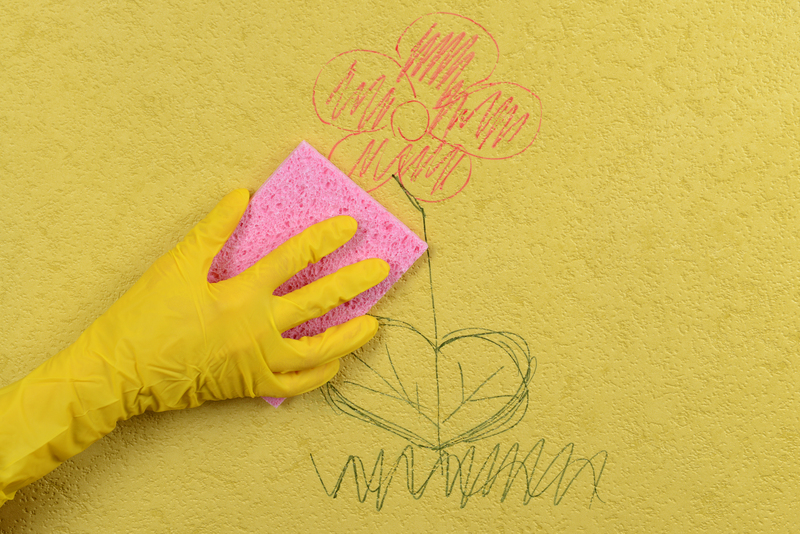Keep Velvet Curtains Looking Majestic with Safe Cleaning Practices
Posted on 18/05/2025
Keep Velvet Curtains Looking Majestic with Safe Cleaning Practices
Velvet curtains exude elegance and add a timeless touch to any room. Their rich texture and deep hues can enhance your interiors, making the ambiance both luxurious and inviting. However, maintaining the plush look and feel of velvet drapery requires diligent care and specific cleaning practices. This comprehensive article guides you through effective, safe ways to clean velvet curtains at home, ensuring they remain the centerpiece of your decor for years to come.
Why Velvet Curtains Require Special Care
Velvet is a sumptuous fabric made from fibers such as silk, cotton, polyester, or a blend. The short, dense pile that gives velvet its signature softness also makes the material delicate. Its texture can quickly flatten or become damaged if cleaned improperly.
- Absorbs Dust Easily: The plush texture traps dust and debris, making regular maintenance essential.
- Water Sensitivity: Some types of velvet, especially silk, can become watermarked or lose sheen when exposed to moisture.
- Pile Crushing: Improper pressure, folding, or even aggressive vacuuming can crush the fibers, leaving permanent marks.
Knowing these challenges is the first step in keeping velvet curtains looking luxurious with safe curtain cleaning techniques.

Routine Maintenance: The Key to Majestic Velvet Curtains
Regular gentle maintenance minimizes the need for intensive cleaning and helps preserve the beauty of your velvet drapes. Here's how to handle everyday care:
1. Weekly Dusting and Freshening
- Vacuum With Care: Use a handheld vacuum or an upholstery attachment on the lowest suction setting. Attach a soft brush to gently remove surface dust and prevent pile crushing.
- Shake and Fluff: If feasible, carefully unhook your curtains and shake them outside, then gently fluff with your hands to restore the pile.
2. Spot Cleaning Spills Immediately
Address spills or stains on velvet as soon as they happen to prevent permanent marks. Here's the safest approach:
- Blot, Don't Rub: Use a clean, dry cotton cloth to blot the spill, absorbing as much as possible. Avoid rubbing, as this can push the stain deeper and crush the fabric fibers.
- Use Gentle Solutions: For water-soluble stains, lightly dab with a slightly damp cloth (distilled water is best) -- always test an inconspicuous area first.
- Let It Air Dry: Allow the spot to air dry completely. Avoid heaters or hair dryers which can shrink or warp velvet curtains.
Deep Cleaning Velvet Curtains: Step-by-Step Guide
While regular maintenance keeps velvet curtains looking pristine, deep cleaning is sometimes necessary. Follow these comprehensive steps for safe, thorough cleaning:
Step 1: Identify Your Velvet Type
Check the care label on your velvet curtain panels. Main types of velvet:
- Silk Velvet: Extremely delicate and usually requires professional dry cleaning.
- Cotton Velvet: More robust, but still needs gentle care; often can be hand-washed or cleaned with upholstery foam.
- Synthetic Velvet (Polyester or Microfiber): Most forgiving and often safe for gentle hand or machine washing. Always confirm with manufacturer instructions.
Step 2: Pre-Test Cleaning Products
Always spot test your chosen cleaning solution on a hidden section of the curtain. Watch for dye bleeding, texture changes, or pile flattening before proceeding.
Step 3: Hand Washing (If Permitted)
- Fill a Tub: Use cool, distilled water and a mild, non-alkaline detergent designed for delicate fabrics.
- Submerge Carefully: Gently move the velvet curtain through the water to loosen dirt; avoid wringing, scrubbing, or twisting the fabric.
- Rinse Several Times: Repeat with clean, cool water until detergent is fully removed.
- Dry Flat: Lay the curtain on a clean, dry towel and roll it up to squeeze out excess water. Reshape and air-dry flat away from sunlight or direct heat sources.
Step 4: Steam Cleaning Velvet Curtains
- Hang curtains in place and use a handheld garment steamer or iron with a steam function.
- Hold the steamer several inches from the fabric to avoid soaking it, gently moving in the direction of the pile.
- Benefits: Steam not only removes dust and light stains but also revives the nap (pile), restoring that signature velvet sheen.
Step 5: When to Opt for Professional Dry Cleaning
If your velvet curtains are made of silk, heavily soiled, or labeled "dry clean only," take them to a trusted dry cleaner with experience handling delicate drapery. Discuss special treatments or any areas of concern to prevent damage.
Tips to Prolong the Life and Luster of Velvet Curtains
- Minimize Sun Exposure: Prolonged sunlight can fade velvet. Use sheer under-curtains or blinds for protection, or rotate panels periodically.
- Keep Away from Humidity: Excess moisture can cause mold growth or watermarking. Ensure your room is well-ventilated.
- Handle with Clean Hands: Oils and dirt transfer easily onto velvet. Always wash hands before adjusting or tying back your velvet drapery.
- Avoid Folding: Store velvet curtains rolled, not folded, to prevent deep creasing.
- Brush the Pile Occasionally: Use a soft-bristle brush or a velvet upholstery brush to gently lift and revive the nap.
Frequently Asked Questions about Cleaning Velvet Curtains
Can I machine wash velvet curtains?
Some synthetic velvets may tolerate gentle machine washing in cold water; however, it's best to check the manufacturer's instructions. Avoid agitation cycles and use a mesh bag for added protection.
How often should velvet curtains be cleaned?
Weekly dusting or vacuuming keeps them radiant. Deep cleaning should be performed once or twice a year or whenever visible soiling occurs.
Are commercial upholstery cleaners safe for velvet?
Certain upholstery foams are formulated for velvet. Always spot test and follow product directions. Avoid products containing bleach or harsh solvents.
What if the velvet curtain pile looks crushed?
Lightly steaming the curtain can rejuvenate the pile. For stubborn flattening, hold a steamer or iron with a steam function a few inches away and brush the fibers gently upwards with a soft brush.
Common Mistakes to Avoid in Velvet Curtain Cleaning
- Scrubbing or Aggressive Rubbing: Can permanently crush the nap and damage fibers.
- Using Hot Water: May shrink or distort the curtain, especially if made from natural fibers.
- Direct Sun Drying: Fades dye and weakens delicate pile.
- Skipping Color Testing: Risk of dye bleeding or discoloration is high if not pre-tested.
- Delaying Spill Treatment: The faster you address accidents, the better your results will be in keeping velvet drapes pristine.
Eco-Friendly and Safe Cleaning Solutions for Velvet Curtains
If you prefer natural cleaning products, these are generally safe for most velvets (always test first):
- White Vinegar Solution: Mix one part white vinegar and three parts distilled water. Dampen a cloth and lightly dab stains, then blot with a clean towel.
- Baking Soda: Sprinkle a light layer over the curtain, allow it to sit for 15-30 minutes, then gently vacuum off with a soft brush attachment.
- Castile Soap: A mild, plant-based soap mixed with water works well for spot cleaning.
These gentle alternatives are ideal for safely cleaning velvet drapes without exposing your household to harsh chemicals.

Professional Cleaning vs. DIY: What's Best for Your Velvet Curtains?
- DIY Cleaning: Suitable for routine dusting, minor spot cleaning and some machine-washable or synthetic velvets.
- Professional Dry Cleaning: Advised for silk velvet, antique drapery, and large or heavily soiled curtains. Experts ensure:
- Proper cleaning agents and methods
- Pile protection and restoration
- Stain removal without risk of damage
For valuable or sentimental velvet window treatments, professional cleaning often offers the greatest peace of mind and proven results for maintaining luxury.
Final Thoughts: Enjoy the Timeless Beauty of Majestic Velvet Curtains
Velvet curtains elevate interior spaces with their rich texture, vibrant colors, and sophisticated appeal. Keeping them looking lush requires a blend of regular care, gentle home cleaning, and professional attention where needed.
- Follow a routine dusting and freshening regimen
- Act quickly on spills using blotting techniques
- Hand-wash or steam when safe, and always spot-test
- Protect from sun, moisture, and rough handling
- When in doubt, consult professional curtain cleaners
With these safe cleaning practices, your velvet drapery will retain its majestic beauty, adding warmth and elegance to your home for many years to come.



